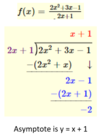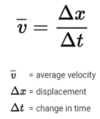Chapter 7: Limits and Continuity Flashcards
(30 cards)
limit
f(x) = 3x + 1
limx→2 f(x) = 7
- f(x) = 3x + 1 is the function
- limx→2 f(x) = 7
- limit of f(x) as x approaches 2 from the left or the right is 7
- the arrow number (x→2) gives you a location in the x direction
- if -2, then you are approaching x from the left only
- if +2 then you are approaching from the right only
- if you have neither -/+ you are approaching from both sides
- limit (7 in this example) is the y value or height of the function
- you are solving for y value as x approaches 2 from both the left and the right side
- x gets closer and closer to the arrow # but technically never gets there
- having an arrow number = x (variable pass to the function) has no effect to the answer of the limit problem
- limits are used for discontinuous functions that have holes
- x
find the limit
limx→3 p(x)

- limit does not exist because as x approaches 3 from the left and the right, it doesn’t zero in on the same height
- from the left it jumps on the top line and rises to y=6, closed circle
- from the right it jumps on the bottom line and rises to y=2, open circle
- 6 <> 2
- However, both one-sided limits do exist
- limx→3- p(x) = 6
- llimx→3<span>+</span> p(x) = 2
formal definition of a limit
limx→c f(x) exists if and only if
- limx→c- f(x) exists
- limx→c+ f(x) exists
- limx→c- f(x) = limx→c+ f(x)
- if you satisfy condition 3 you are good
- undefined <> undefined
- nonexistent <> nonexistent
- When we say a limit exists, it means that the limit equals a _____ number
- some limits equal ∞ or -∞, so we say that they _____ exist, aka __ __ __
- finite
- don’t
- DNE
asymptote
- line that a curve approaches, as it heads towards infinity
- three types:
- horizontal
- describe the behavior of a graph as the input approaches ∞ or −∞
- vertical
- describe the behavior of a graph as the output approaches ∞ or −∞
- oblique
- horizontal
- direction can be positive or negative
- distance between the curve and the asymptote tends to zero as they head to infinity (or −infinity)

vertical asymptote of a rational function

- describe the behavior of a graph as the output approaches ∞ or −∞
- factor the numerator and denominator, if possible
- cancel any factors that are in both the numerator and denominator
- set the denominator equal to zero and solve for x
- x - 3 = 0 → x = 3
- x + 1 = 0 → x = -1

horizontal asymptote of a rational function
- N = degree of the numerator
- D = degree of the denominator
- N < D
- horizontal asymptote is y = 0
- 2x / 3x2 +1
- 1 < 2
- y = 0
- N = D
- horizontal asymptote is y = ratio of the leading coefficients
- 2x2 / 3x2+1
- y = ⅔
- ⅔ is also the answer to the limit
- N > D
- then there is no horizontal asymptote
- *Slant asymptotes occurs when the degree of the numerator is exactly one more than the degree of the denominator.
- 2x2 / 3x+1
slant asymptote
- N = degree of the numerator
- D = degree of the denominator
- degree of the numerator is exactly one more than the degree of the denominator
- 2x2 / 3x+1
- To find equation of the slant asymptote
- divide the fraction and ignore the remainder

slant asymptote
a graph of a rational function will never cross a vertical asymptote, but the graph may cross a horizontal or slant asymptote. Also, the graph of a rational function may have several vertical asymptotes, but the graph will have at most one horizontal or slant asymptote.
formula to approximate the distance that an object falls freely from the rest in t seconds
h(t) = 16t2
h = distance traveled by object t = amount of time since the object was dropped
distance formula
rate formula
distance = rate * time
rate = distance / time
average speed formula
- find the distance traveled for the beginning point
- h(t) = 16t2 = 16(1)2 = 16
- find the distance traveled for the end point
- h(t) = 16t2 = 16(2)2 = 64
- calculate the average speed

average speed formula
what are the x intercepts
- x-intercepts are
- the value of t when h(t) = 0
- when the object hits teh ground
- to find x-intercepts
- equate function to 0 and solve for t
- h(t) = -16t2 = 96 t
- 0 = -16t(t - 6)
- -16t = 0 → t = 0
- t - 6 = 0 → t = 6
- object hit the ground at 0 & 6 seconds
average speed is the _____ of the ____ ____ joining the points on the graph
- slope
- secant line

average / instantaneous velocity formula

instantaneous speed
how is it determined
- the limit of the average speed as the elapsed time approaches zero
- determined by computing average velocities over intervals [t0, t1] that decrease in time
- As t1 approaches t0, the average velocities typically approach a unique # → the instantaneous speed
- because the time interval is so short, the avg velocity gives a good approximation to the instantaneous velocity at t = 1

instantaneous speed
- the limit of the average speed as the elapsed time approaches zero
- there’s a hole at (1,32) because if you plug 1 into t in the function you get 0/0 which is undefined
- you’re trying to determine an average speed — which equals total distance divided by elapsed time
- from t = 1 to t = 1 no time has passed, and “during” this point in time, the ball doesn’t travel any distance

continuity of polynomial functions
all polynomial functions are continuous everywhere
continuity of rational functions
- rational functions: quotient of 2 polynomial functions
- continuous over their entire domain except at x values not in their domain
- (x values where the denominator = 0)
the limit at a hole
- the limit at a hole is the height of the hold
- In the graph below
- both functions in have the same limit as x approaches 2; the limit is 4
- the fact that r(2) =1 and s(2) is undefined are irrelevant
- for both functions, as x zeroes in on 2 from either side, the height of the function zeroes in on the height of the hole — that’s the limit.

slope of the tangent line
- just as the average velocities approach a limit oas t approaches 1, so does the secant line
- both approach the same limit
- slope of secant line approaches slope of tangent line
- instantaneous velocity at t = 1 is the slope of the line tangent

derivative-hole connection
- a derivative always involves
- the undefined fraction 0/0
- the limit of a function with a hole
definition of continuity
- a function f(x) is continuous at a point x = a if the following three conditions are satisfied
- if the third condition is met, then the top 2 are met
- left & right sides cannot be DNE or undefined
- f(a) is defined
- lim x→ a f(x) exists
- f(a) = lim x→ a f(x)
when does a limit fails to exist
- at a vertical asymptote
- called an infinite discontinuity
- like at x = 3 on p(x)
- at a jump discontinuity, like where x = 3 on q(x)
- with a limit at infinity of an oscillating function
- like sin x
- graph goes up/down forever, never zeroing on a single height





